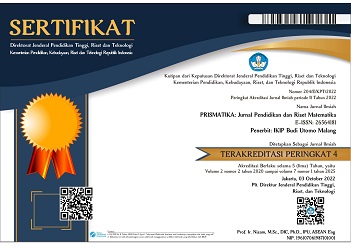PEMAHAMAN KONSEP GRUP MAHASISWA CALON GURU MATEMATIKA DENGAN KEMAMPUAN MATEMATIKA TINGGI
Abstract
The study aims to describe the understanding of group concepts in prospective mathematics teacher with high mathematical abilities. This research is a descriptive qualitative research, with a research subject is a prospective mathematics teacher who have taken group theory courses. The subjects were selected according to the criteria of having high mathematical abilities based on mathematical ability tests, having good communication skills and being able to explain. Data collection was carried out through providing group concept understanding tests followed by interviews. Written tests and interviews were conducted twice for the purposes of triangulating data through time triangulation. Regarding to the discussion section, it can be summarized that subjects with high mathematical abilities can define and show a group fulfilling the traits in detail.
References
Ball, D. L., Thames, M. H., & Phelps, G. (2008). Content knowledge for teaching: What makes it special? Journal of Teacher Education, 59(5), 389-407. doi:10.1177/0022487108324554.
Cathcart, W. G., Pothier, Y., Vance, J. H., & Bezuk, N. S. (2006). Learning Mathematics in Elementary and Middle Schools: A Learner-Centred Approach. Upper Saddle River: Pearson Prentice Hall.
Dubinsky, E., Dautermann, J., Leron, U., & Zazkis, R. (1994). On learning fundamental concepts of group theory. Educational Studies in Mathematics; an International Journal, 27(3), 267-305. doi:10.1007/BF01273732.
Findell, B. R. (2001). Learning and Understanding in Abstract Algebra. Unpublished, PhD Thesis. University of New Hampshire.
Gallian, J. A. (1994). Contemporary Abstract Algebra (3rd edition). Lexington, MA: D. C. Heath.
Hiebert, J., & Carpenter, T.P. (1992). Learning and teaching with understanding. In D.A. Grouws (Ed.), Handbook of research on mathematics teaching and learning (pp. 65- 100). New York: Macmillan.
Miles dan Huberman. (2008). Qualitative Data Analysis. London: SAGE Publications.
Moleong, Lexy J. (2007). Metodologi Penelitian Kualitatif. Bandung: Remaja Rosdakarya Offset.
Murray, E., Baldinger, E., Wasserman, N., Broderick, S., & White, D. (2017). Connecting advanced and secondary mathematics. Issues in the Undergraduate Mathematics Preparation of School Teachers, 1. Retrieved from https://digitalcommons.montclair.edu/mathsci-facpubs/4
NCTM. (2000). Principle and Standards for School Mathematics. Reston VA: NCTM.
Pramasdyahsari, A.S. (2014). The Profile of Primary School Students’ Conceptual Understanding of Equivalent Fractions Based on Kolb’s Learning Styles. Thesis: Universitas Negeri Surabaya.
Pramasdyahsari, A.S., Setyawati, R., & Albab, I. (2019). Connecting university mathematics and school mathematics to address Klein’s double discontinuity: A case of ring theory. Beta: Jurnal Tadris Matematika, 12(2), 122-132. https://doi.org/10.20414/betajtm.v12i2.336.
Sugiyono. (2008). Metode Penelitian Pendidikan Pendekatan Kuantitatif, Kualitatif, dan R&D. Bandung: Alfabeta.
Sugiyono. (2012). Memahami Penelitian Kualitatif. Bandung: Alfabeta.
Titova. (1998). Understanding Abstract Algebra Concepts. Becker College.
Wasserman, N. H. (2016). Abstract algebra for algebra teaching: Influencing school mathematics instruction. Canadian Journal of Science, Mathematics and Technology Education, 16(1), 28-47. Doi:10.1080/14926156.2015.1093200.







.png)




